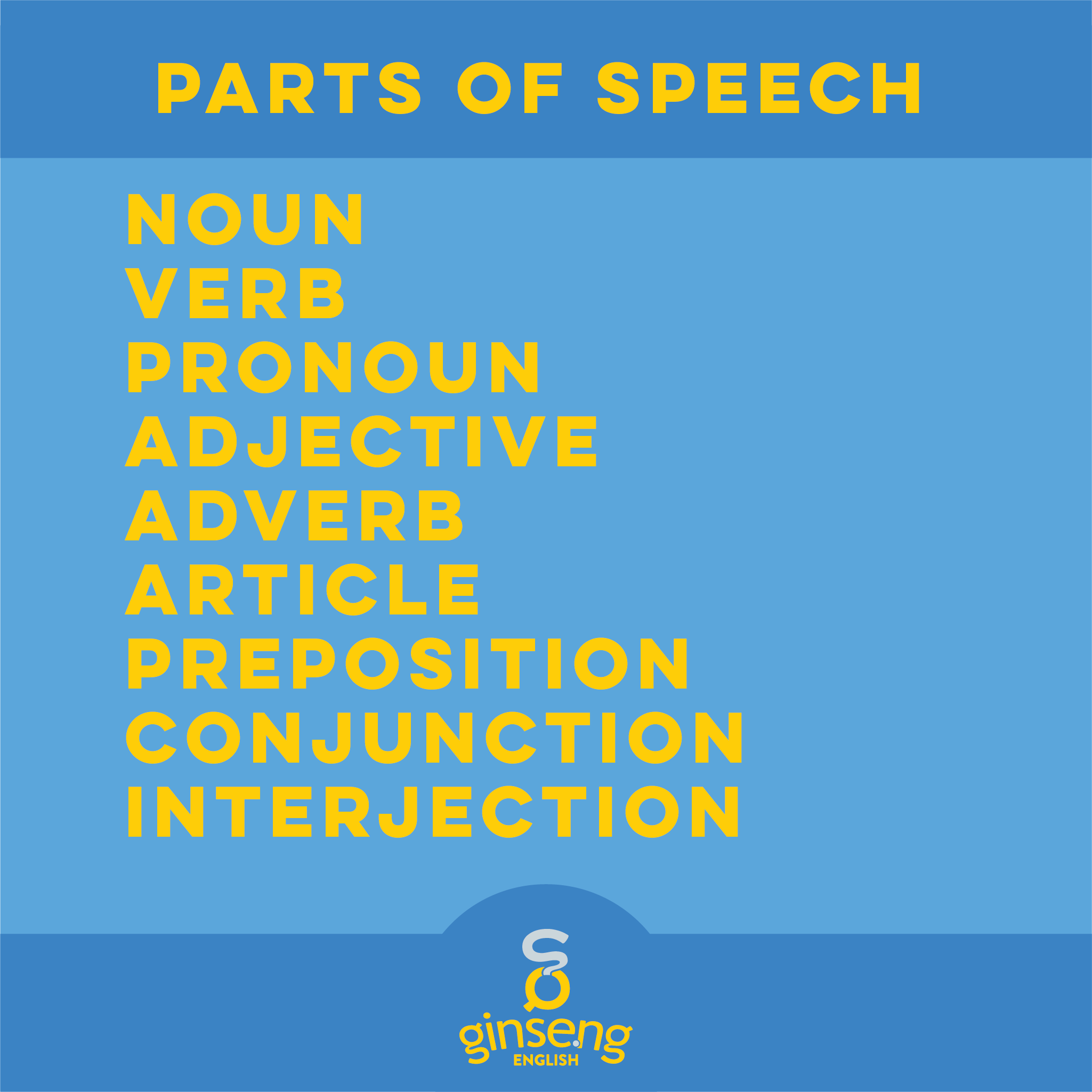Parts of Speech in English
Every word in a language can be categorized by its part of speech. Parts of speech (also known as word classes) tell us what a word does, along with how it functions and makes meaning. We can also group parts of speech into lexical words, which carry a lot of meaning, and function words (or grammar words), which help us make sentences and show the relationship between things.
Overview of English Parts of Speech
How Many Parts of Speech are There?
There are a total of 9 different parts of speech in English: nouns, pronouns, verbs, adverbs, adjectives, prepositions, conjunctions, interjections, and articles (or determiners). Read on for a brief explanation of each!
If an article tells you that there are only 8, they are often missing articles or determiners, which are a really important one, especially for language learners.
Why Learn about Parts of Speech?
If you’re looking for the parts of speech in English grammar, you’ve come to the right place! If you’re trying to learn English online by yourself, understanding the parts of speech is a good place to start. They can help you to understand the structure of the language to guide your studying. If you are looking for an in-depth guide to English grammar, our complete English grammar guide might be more helpful.
Frequency of Different Parts of Speech
At Ginseng English, we believe in taking a research-informed, strategic approach to learning English. So understanding the general frequency of the different parts of speech is helpful. Take a look at the following table showing the proportion of the different parts of speech in conversational English and academic prose. (Note that the percentages are approximate and may not total 100% because the original categorization was slightly different from ours. This is only to give a general sense of the proportions.
| Conversation | Academic | ||
|---|---|---|---|
| Lexical | Nouns | 15% | 30% |
| Verbs | 12.5% | 10% | |
| Adjectives | 2.5% | 10% | |
| Adverbs | 5% | 3% | |
| Function | Pronouns | 16.5% | 4% |
| Prepositions | 5.5% | 15% | |
| Determiners | 4.5% | 10% | |
| Conjunctions | 4.5% | 5% |
Source: Biber, et. al., (1999). Longman Grammar of Spoken and Written English.
Nouns
Lots of teachers say a noun is a person, place, or thing! You should also add ideas to that list. Proper nouns in English start with a capital letter, but other nouns do not.
Here are some examples of nouns:
This is my father.
We are from Ecuador.
I have two dogs.
On this holiday we celebrate our independence.
Nouns in English can be singular or plural. to form a regular plural, we simply add -s or -es to the end of a noun. Irregular plurals do not follow this rule.
Here is a complete article on Nouns in English.
Pronouns
Pronouns are used to stand in place for a noun, because in English we don’t like to repeat nouns again and again. The noun that a pronoun refers back to is called its antecedent. Examples of common pronouns in English are he, she, it, him, her, mine, this, that, myself. Pronouns in English change form to show, for example, whether they are singular or plural, subjects or objects, male or female or neither.
Here are examples of some basic pronouns:
Can I have that?
We are with her.
I think I need something to eat.
Here is a complete article on pronouns in English.
Verbs
Verbs are words we use to talk about actions, states, and occurrences (things that happen). Many people would say that nouns and verbs are the most important and useful parts of speech in any language.
The main verb in a sentence has a subject, generally a noun or pronoun referring to the person or thing that the sentence is about. For example, in the sentence Maria walks, the verb is walks and the subject is Maria. Verbs can change form to ‘agree with’ their subject.
Here are some examples of verbs:
They cook every night
We went to the store.
This will help the people.
Notice in that last example that a verb can be more than one word. This is called a compound verb. There are two types of verb: main verbs and helping verbs (also called auxiliary verbs).
Adjectives
Adjectives are words that describe, or modify, nouns. They generally (but not always) come before nouns. In the following phrases, the adjectives are in bold:
a big party some terrible news the best pizza an interesting idea a really strong leader
For more information, check out our list of the most common adjectives in English.
Adverbs
Like adjectives, adverbs are describing words. But while adjectives describe only nouns, adverbs can describe verbs, adjectives, other adverbs, or entire sentences.
Because adverbs are so versatile, it is hard to say much that applies to all adverbs generally. They can appear at different places in the sentence: at the beginning, before a verb, before an adjective, after a verb, or at the end of a sentence.
walk slowly speak clearly immediately fell run fast
Many adverbs end in -ly, and many adjectives can be transformed into adverbs by adding the suffix -ly: slow becomes slowly, eventual becomes eventually, stupid becomes stupidly, etc.
One of the most basic types of adverbs are adverbs of frequency. Click through to read more about those.
Articles
The articles in English are a, an (indefinite articles) and the (definite article). Articles can be really tricky, but the basic idea is that we use indefinite articles when we are introducing a new noun to our listeners or not referring to a specific object. On the other hand, we use definite articles to refer to a specific object that our listeners already know about.
Note: You may find articles out there claiming that articles are a type of adjective. This is simply incorrect. At one time (about 300 years ago) some people thought this, but this is not a current view.
Note: Some grammars treat articles as a subcategory of determiners. This is a valid view. Determiners include possessive determiners such as my and your, as well as demonstrative determiners such as this, that, these, and those.
Prepositions
Prepositions are, to put it simply, words that are placed before (pre-position) nouns or pronouns to connect them to other parts of speech in a sentence. There are different types of preposition that give different types of information: prepositions of time, prepositions of place, prepositions of direction.
Conjunctions
Conjunctions are words that connect. They can connect, for example, a list of nouns in a series. But most of the time, when we are talking about conjunctions, we are talking about connecting one clause to another clause in the same sentence. There are two types of conjunctions: coordinating conjunctions and subordinating conjunctions.
Coordinating Conjunctions
Coordinating conjunctions connect two clauses of equal importance into what we call a compound sentence. There are not many coordinating conjunctions. You can remember them with the acronym FANBOYS: for, and, nor, but, or, yet, so.
Subordinating Conjunctions
When we connect clauses using subordinating conjunctions, we are giving one clause more importance than the other. The less important clause is called a subordinate clause. Two or more clauses combined with subordinating conjunctions are called a complex sentence. Some common subordinating conjunctions are because, although, before, since, when, while, and if.
Interjections
Interjections are funny words: ouch, wow, hmm, oops, well, geez.. They are sort of the black sheep of English grammar. They are not connected to the other words in a sentence (they are inter-jected, put in between, the other words). Generally they add emotion to a sentence. Here are some examples of interjections:
Wow, I'm so tired.
Ouch! I cut my finger.
Oh, you moved to Manhattan

